Ganesh Stotram (Stuti, Sloka) with Meaning for Kids, Elders (Sanskrit, Kannada, English)
Namaste friends, how are you doing today? Welcome to #BhagavanBhakthi website / blog.
Bhagavan Lord Sri Krishna (Lakshmi Narasimha) (Vitthal) (Vishnu) (Rama) (Trivikrama) and Goddess Sri Rukmini (Lakshmi), Lord Shiva, Goddess Parvati and Lord Ganesh blessings to you and your family!
In this website / blog, you will always learn about #Hinduism #Sanskrit language.
Also subscribe to my YouTube channel from this link #BhagavanBhakthi to view videos about #Hinduism #Sanskrit language.
Just before going to “Ganesh Stotram (Stuti, Sloka) with Meaning for Kids, Elders (Sanskrit, Kannada, English)“, let us know a brief, basic and very important information.
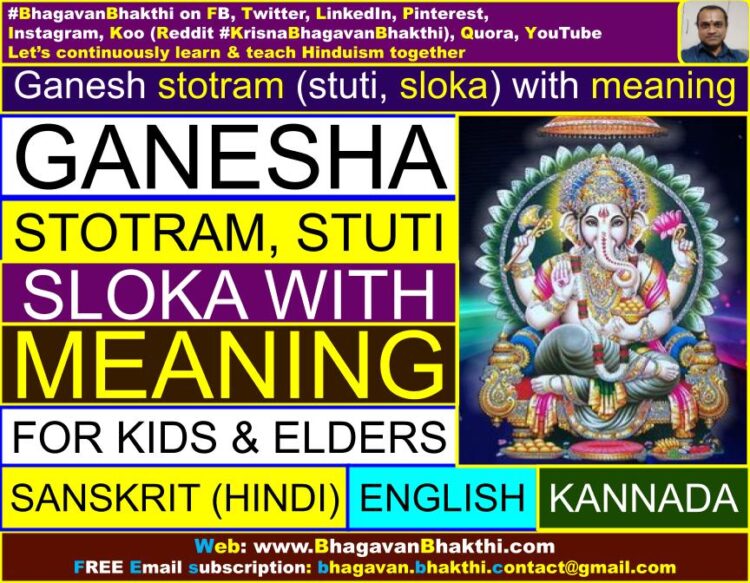
Lord Ganesha is always one of the favorite Gods in Hinduism. Every auspicious work is done only after doing the pooja of Lord Ganesha.
Lord Ganesha’s parents names are Lord Shiva and Mother Sri Parvati Devi. Lord Ganesha’s brother name is Kartikeya (also known as Skanda / Shanmukha / Subramanya / Murugan etc.)
Now, let us start to know the very divine and auspicious stotrams (stuti, sloka) of Lord Ganesha:
List of the Lord Ganesha stotrams (stuti, slokas) are as given below:
1. वक्रतुण्ड महाकाय सूर्यकोटि समप्रभ।
निर्विघ्नम् कुरु मे देव सर्व कार्येषु सर्वदा॥
ವಕ್ರತುಂಡ ಮಹಾಕಾಯ ಕೋಟಿಸೂರ್ಯ ಸಮಪ್ರಭ
ನಿರ್ವಿಘ್ನಂ ಕುರುಮೇ ದೇವ ಸರ್ವಕಾರ್ಯೇಷು ಸರ್ವದಾ
vakratuṇḍa mahākāya kōṭisūrya samaprabha
nirvighnaṁ kurumē dēva sarvakāryēṣu sarvadā
Word by word meaning of the above stotram (stuti, sloka) : Vakratunda – Someone who is having a curved trunk; Mahakaya – He is the one who is having very huge form (body); Surya – Lord Sun; Koti – Crore; Sama – Equal; Prabha – Splendor;
Nirvighnam – He is the one who clears all the obstacles; Kuru + me – Give + Me; Deva – Oh God; Sarva – All; Kaaryeshu – Endeavours; Sarvada – Always.
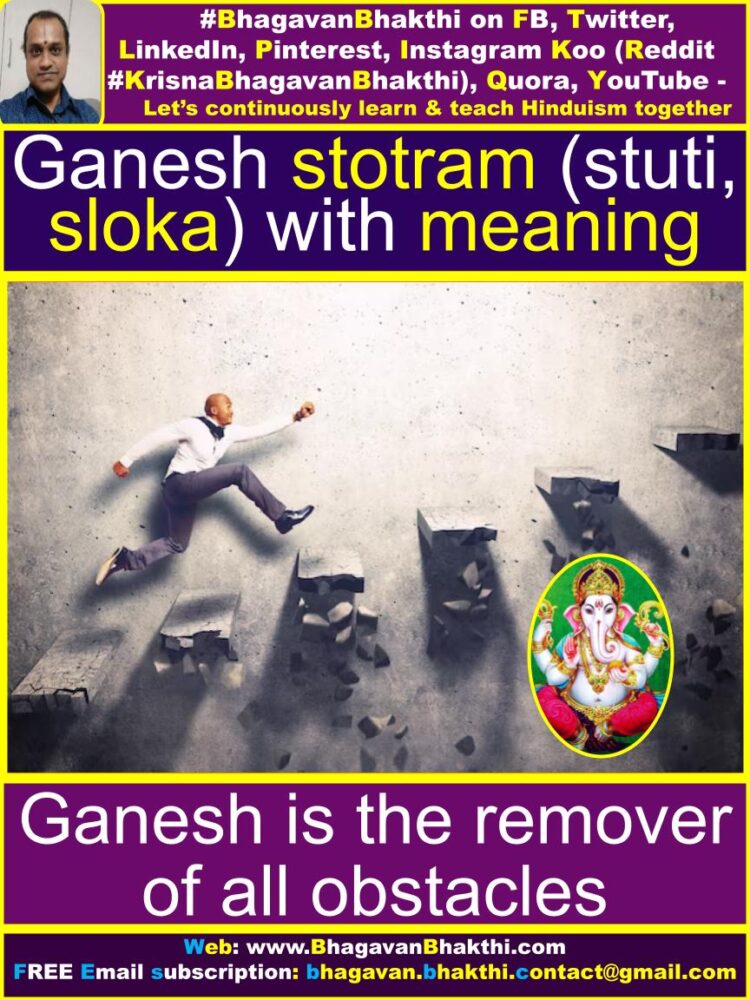
Full meaning of the above stotram (stuti, shloka) : Oh Lord Ganesha, you are the one who is having the curved trunk and you are the one who is having a huge body.
You are equal to Koti (Crore) Suns (Lord Surya) and have the great splendor of these Koti Suns. Lord Ganesha, you are the one who clears all the obstacles (that’s why Lord Ganesha is known as Vighneshwara / Vighna-nashaka).
Oh Lord Ganesha, give me blessings so that all my endeavors always sees the winning situation.
2. अगजानन पद्मार्कं गजाननं अहर्निशम् ।
अनेकदंतं भक्तानां एकदन्तं उपास्महे ॥
ಅಗಜಾನನ ಪದ್ಮಾರ್ಕಂ ಗಜಾನನಂ ಮಹರ್ನಿಶಂ |
ಅನೇಕದಂತಂ ಭಕ್ತಾನಾಂ ಏಕದಂತ ಊಪಾಸ್ಮಹೇ ||
agajānana padmārkaṁ gajānanaṁ maharniśaṁ |
anēkadantaṁ bhaktānāṁ ēkadanta ūpāsmahē ||
Word by word meaning of the above stotram (shloka) : Agaja = Mother Sri Parvati Devi; Aanana = face; Padma = lotus flower; Arkam = sun; Gaja = elephant; Aananam = faced; AhaH = day; Nisham = night; Aneka = Multiple; Dan = giver;
Tam = you / your; Bhaktaanaam = to all his (Lord Ganesha) devotees; Eka = single; Dantam = tooth (having one / single tooth); Upasmahey = I meditate upon you (Lord Ganesha).
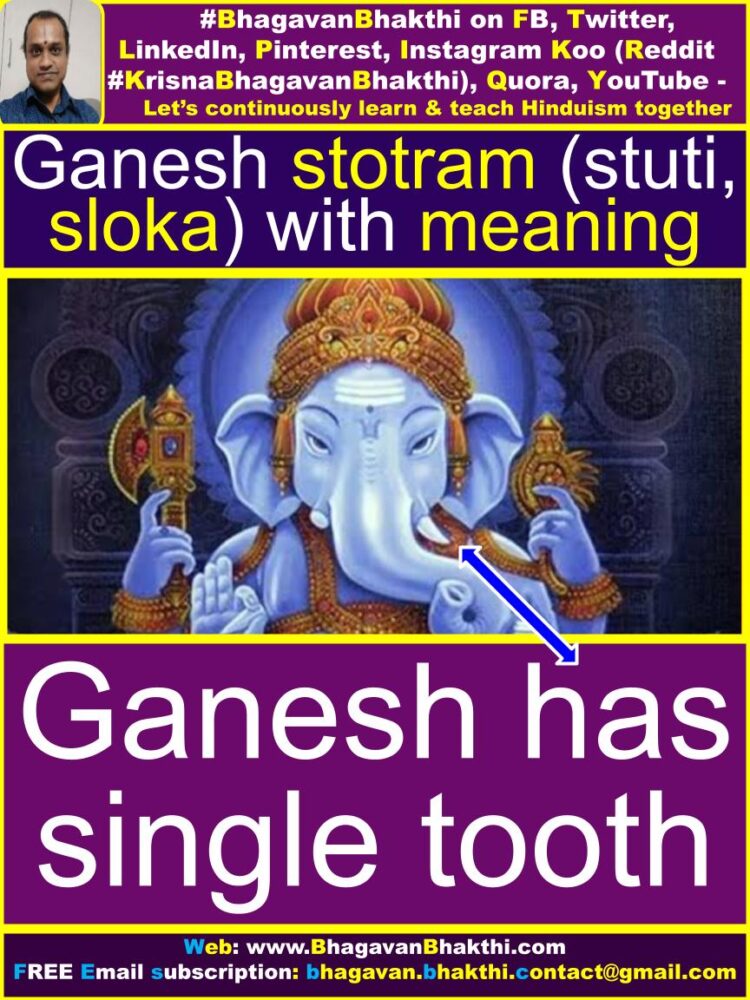
Full meaning of the above stotram (shloka) : Mother Sri Parvati Devi upon seeing the elephant-faced Lord Ganesha all the time, Sri Parvati Devi’s face lighted up, just like how a lotus blooms when the Sun rays falls on it (Lotus flower) and,
I meditate upon you Oh Lord Ganesha who is having a single tusk and you are the giver of many boons to your followers and devotees.
3. गजाननं भूत गणादि सेवितं कपित्थ जम्बू फलसार भक्षितं |
उमासुतं शोक विनाशकारणं नमामि विघ्नेश्वर पाद पंकजं ||
ಗಜಾನನಂ ಭೂತ ಗಣಾದಿ ಸೇವಿತಂ ಕಪಿತ್ಥ ಜಂಬೂ ಫಲಸಾರ ಭಕ್ಷಿತಂ |
ಉಮಾಸುತಂ ಶೋಕ ವಿನಾಶಕಾರಣಂ ನಮಾಮಿ ವಿಘ್ನೇಶ್ವರ ಪಾದ ಪಂಕಜಂ ||
gajānanaṁ bhūta gaṇādi sēvitaṁ kapit’tha jambū phalasāra bhakṣitaṁ |
umāsutaṁ śōka vināśakāraṇaṁ namāmi vighnēśvara pāda paṅkajaṁ ||
Word by word meaning of the above stotram (stuti, shloka) : Gajaananam = Lord Ganesh, who is having an Elephant face; Bhoota = Bhoota (celestial) present in Kailasha; Ganaadhi = Gana and others;
Sevitam = Doing Seva (serving); Kapitta = Wood Apple; Jamoo = Rose Apple; Phala = Fruits; Saara = Juice; Bhakshitam = Eating; Umaasutam = Son of Mother Uma; Shoka = Sorrows; Vinaasha = Destroyer;
Kaaranam = The reason; Namaami = Namaste; Vigneshwara = Lord Vigneshwara (Ganesha); Paada = Feet; Pankajam = Lotus flowered (feet).
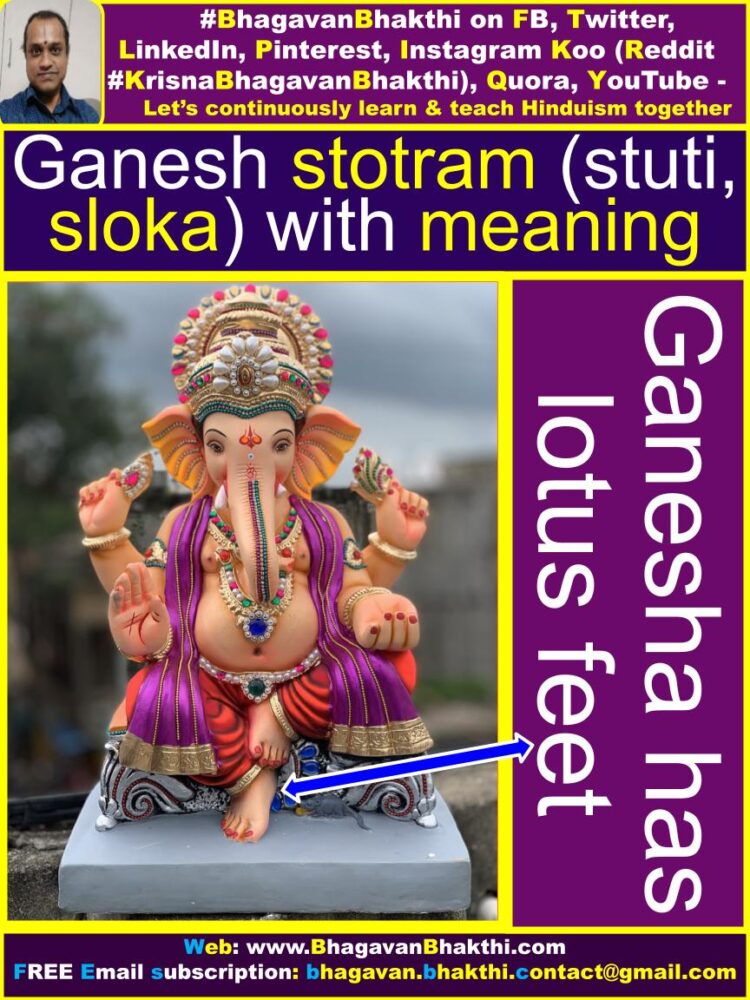
Full meaning of the above stotram (shloka) : Oh Lord Gajananam (Ganesha), who is having an Elephant Face. You (Ganesha) are the one who is Served by the Bhootas, Ganas (Celestial people who are present in Kailasa / Kailash) and Others.
Ganesha, you are the one who likes to eat the Core of Kapitta (Wood Apple) and Jambu (Rose Apple) Fruits. You are the Son of Mother Uma Devi (Another name of Parvati Devi) and the cause of destruction of all sorrows.
Thus, I (All the devotees) do Namaste at your Lotus-Feet Oh Vighneshwara (the God who removes obstacles – Another name of Ganesha).

4. Below stotram (shloka) is known as “Sri Ganesha Dwadashanama Stotra” (Dwadasaha = 12 shlokas)
This stotram (stuti, shloka) is given in Sanskrit (Hindi), Kannada and English script as below with meaning in English:
प्रणम्य शिरसा दॆवं गौरीपुत्रं विनायकं ।
भक्तावासं स्मरॆन्नित्यं आयुः कामार्थ सिद्धये ॥ १ ॥
प्रथमं वक्रतुंडं च ऎकदंतं द्वितीयकं।
तृतीयं कृष्णपिंगाक्षं गजवक्त्रं चतुर्थकं॥ २ ॥
लंबॊदरं पंचमं च षष्ठं विकटमॆव च ।
सप्तमं विघ्नराजॆंद्रं धूम्रवर्णं तथाष्टमं ॥ ३ ॥
नवमं भालचंद्रं च दशमं तु विनायकं।
ऎकादशं गणपतिं द्वादशं तु गजाननं॥ ४ ॥
द्वादशैतानि नामानि त्रिसंध्यं यः पठॆन्नरः ।
न च विघ्नभयं तस्य सर्वसिद्धिकरं प्रभॊ ॥ ५ ॥
विद्यार्थि लभते विद्यां धनार्थी लभते धनं ।
पुत्रार्थि लभते पुत्रान् मॊक्षार्थि लभते गतिं॥ ६ ॥
जपॆत् गणपतिस्तॊत्रं षड्भिर्मासैः फलं लभॆत् ।
संवत्सरॆण सिद्धिं च लभते नात्र संशयः ॥ ७ ॥
अष्टेभ्यो ब्राह्मणॆभ्यश्च लिखित्वा यः समर्पयॆत् ।
तस्य विद्या भवॆत् सर्वा गणॆशस्य प्रसादतः ॥ ८ ॥
|| इति श्री नारदपुराणे संकटनाशनम गणेश स्तोत्रम सम्पूर्णम ||
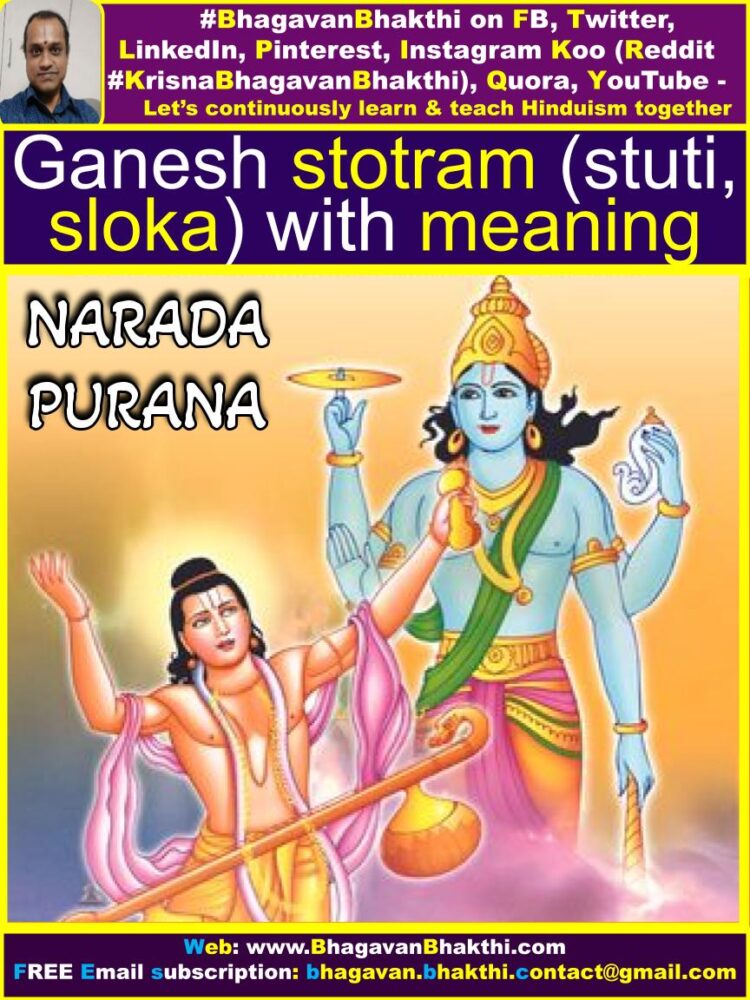
ಪ್ರಣಮ್ಯ ಶಿರಸಾ ದೇವಂ ಗೌರೀಪುತ್ರಂ ವಿನಾಯಕಂ |
ಭಕ್ತಾವಾಸಂ ಸ್ಮರೇನ್ನಿತ್ಯಂ ಆಯುಃ ಕಾಮಾರ್ಥ ಸಿದ್ಧಯೆ || ೧ ||
ಪ್ರಥಮಂ ವಕ್ರತುಂಡಂ ಚ ಏಕದಂತಂ ದ್ವಿತೀಯಕಂ|
ತೃತೀಯಂ ಕೃಷ್ಣಪಿಂಗಾಕ್ಷಂ ಗಜವಕ್ತ್ರಂ ಚತುರ್ಥಕಂ|| ೨ ||
ಲಂಬೋದರಂ ಪಂಚಮಂ ಚ ಷಷ್ಠಂ ವಿಕಟಮೇವ ಚ |
ಸಪ್ತಮಂ ವಿಘ್ನರಾಜೇಂದ್ರಂ ಧೂಮ್ರವರ್ಣಂ ತಥಾಷ್ಟಮಂ || ೩ ||
ನವಮಂ ಭಾಲಚಂದ್ರಂ ಚ ದಶಮಂ ತು ವಿನಾಯಕಂ|
ಏಕಾದಶಂ ಗಣಪತಿಂ ದ್ವಾದಶಂ ತು ಗಜಾನನಂ|| ೪ ||
ದ್ವಾದಶೈತಾನಿ ನಾಮಾನಿ ತ್ರಿಸಂಧ್ಯಂ ಯಃ ಪಠೇನ್ನರಃ |
ನ ಚ ವಿಘ್ನಭಯಂ ತಸ್ಯ ಸರ್ವಸಿದ್ಧಿಕರಂ ಪ್ರಭೋ || ೫ ||
ವಿದ್ಯಾರ್ಥಿ ಲಭತೆ ವಿದ್ಯಾಂ ಧನಾರ್ಥೀ ಲಭತೆ ಧನಂ |
ಪುತ್ರಾರ್ಥಿ ಲಭತೆ ಪುತ್ರಾನ್ ಮೋಕ್ಷಾರ್ಥಿ ಲಭತೆ ಗತಿಂ|| ೬ ||
ಜಪೇತ್ ಗಣಪತಿಸ್ತೋತ್ರಂ ಷಡ್ಭಿರ್ಮಾಸೈಃ ಫಲಂ ಲಭೇತ್ |
ಸಂವತ್ಸರೇಣ ಸಿದ್ಧಿಂ ಚ ಲಭತೆ ನಾತ್ರ ಸಂಶಯಃ || ೭ ||
ಅಷ್ಟೆಭ್ಯೊ ಬ್ರಾಹ್ಮಣೇಭ್ಯಶ್ಚ ಲಿಖಿತ್ವಾ ಯಃ ಸಮರ್ಪಯೇತ್ |
ತಸ್ಯ ವಿದ್ಯಾ ಭವೇತ್ ಸರ್ವಾ ಗಣೇಶಸ್ಯ ಪ್ರಸಾದತಃ || ೮ ||
|| ಇತಿ ಶ್ರೀ ನಾರದ ಪುರಾಣಿ ಸಂಕಟ ನಾಶನಂ ಗಣೇಶ ಸ್ತೋತ್ರಂ ಸಂಪೂರ್ಣಂ ||
praṇamya śirasā dēvaṁ gaurīputraṁ vināyakaṁ |
bhaktāvāsaṁ smarēnnityaṁ āyuḥ kāmārtha sid’dhaye || 1 ||
prathamaṁ vakratuṇḍaṁ ca ēkadantaṁ dvitīyakaṁ |
tr̥tīyaṁ kr̥ṣṇapiṅgākṣaṁ gajavaktraṁ caturthakaṁ || 2 ||
lambōdaraṁ pan̄camaṁ ca ṣaṣṭhaṁ vikaṭamēva ca |
saptamaṁ vighnarājēndraṁ dhūmravarṇaṁ tathāṣṭamaṁ || 3 ||
navamaṁ bhālacandraṁ ca daśamaṁ tu vināyakaṁ |
ēkādaśaṁ gaṇapatiṁ dvādaśaṁ tu gajānanaṁ || 4 ||
dvādaśaitāni nāmāni trisandhyaṁ yaḥ paṭhēnnaraḥ |
na ca vighnabhayaṁ tasya sarvasid’dhikaraṁ prabhō || 5 ||
vidyārthi labhate vidyāṁ dhanārthī labhate dhanaṁ |
putrārthi labhate putrān mōkṣārthi labhate gatiṁ || 6 ||
japēt gaṇapatistōtraṁ ṣaḍbhirmāsaiḥ phalaṁ labhēt |
sanvatsarēṇa sid’dhiṁ ca labhate nātra sanśayaḥ || 7 ||
aṣṭebhyo brāhmaṇēbhyaśca likhitvā yaḥ samarpayēt |
tasya vidyā bhavēt sarvā gaṇēśasya prasādataḥ || 8 ||
|| iti śrī nārada purāṇi saṅkaṭa nāśanaṁ gaṇēśa stōtraṁ sampūrṇaṁ ||
Shloka 1 : Word by word meaning of the above stotram (shloka) : praNamya = Namaste; shirasA = With head bowing down; dEvaM = Deva (God) gaurIputraM = Son of Gauri Devi (Parvati Devi); vinAyakaM = Vinayaka (Ganesha);
bhaktAvAsaM = With full bhakti (devotion); smarEnnityaM = Should do smarana (remember) everyday; AyuH = Lifespan; kAmArtha = What we wish; siddhaye = We will gain.
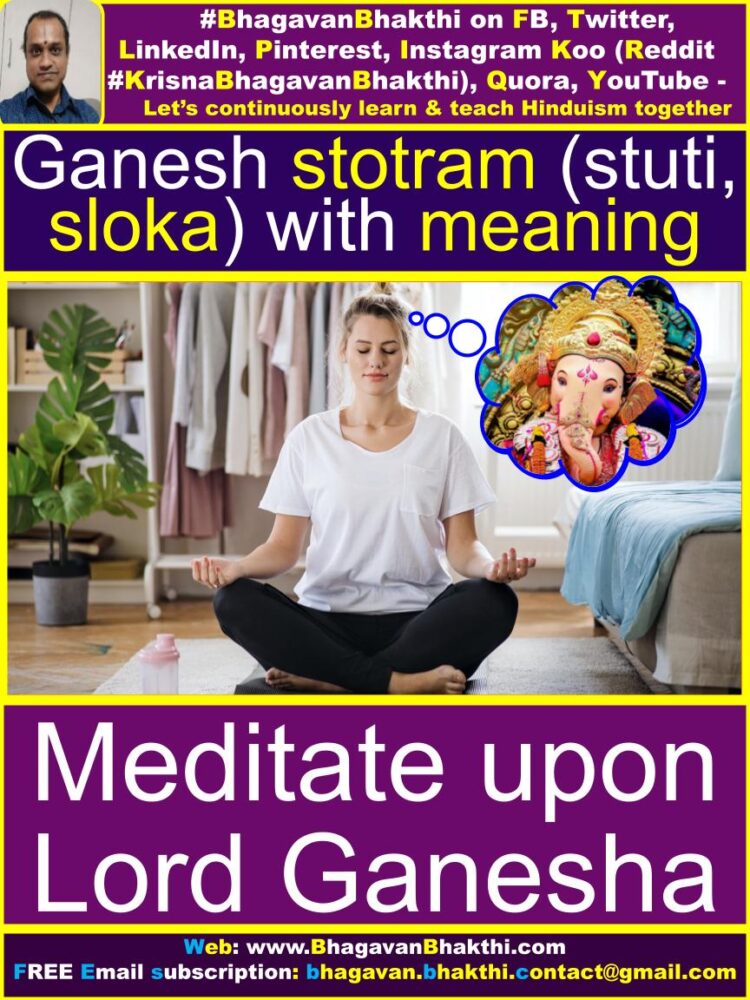
Shloka 1 : Full meaning of the above stotram (shloka) : A person who is learned in vaidika (Sanatana Dharma) education, who wishes for more life like lifespan, wealth and love,
should do namaste with his head bowing down to Lord Vinayaka (Ganesha) on everyday basis, and remember (meditation) him (Ganesha), who is the son of Goddess Sri Gauri Devi (Parvati).
Shloka 2 : Word by word meaning of the above stotram (shloka) : prathamaM = First; vakratuNDaM = Vakratundam (Someone having broken tusk); cha = And; EkadaMtaM = Ekadanta (Someone having single tusk); dvitIyakaM = Second;
tRutIyaM = Third; kRuShNapiMgAkShaM = Someone with reddish black eyes; gajavaktraM = Someone who has the face of an Elephant; chaturthakaM = Fourth.
Shloka 2 : Full meaning of the above stotram (shloka) : We have to think him (Ganesha) first as god with broken tusk, second as the Lord with single tusk, third as the one with reddish black eyes, fourth as the one who has the face of an elephant.
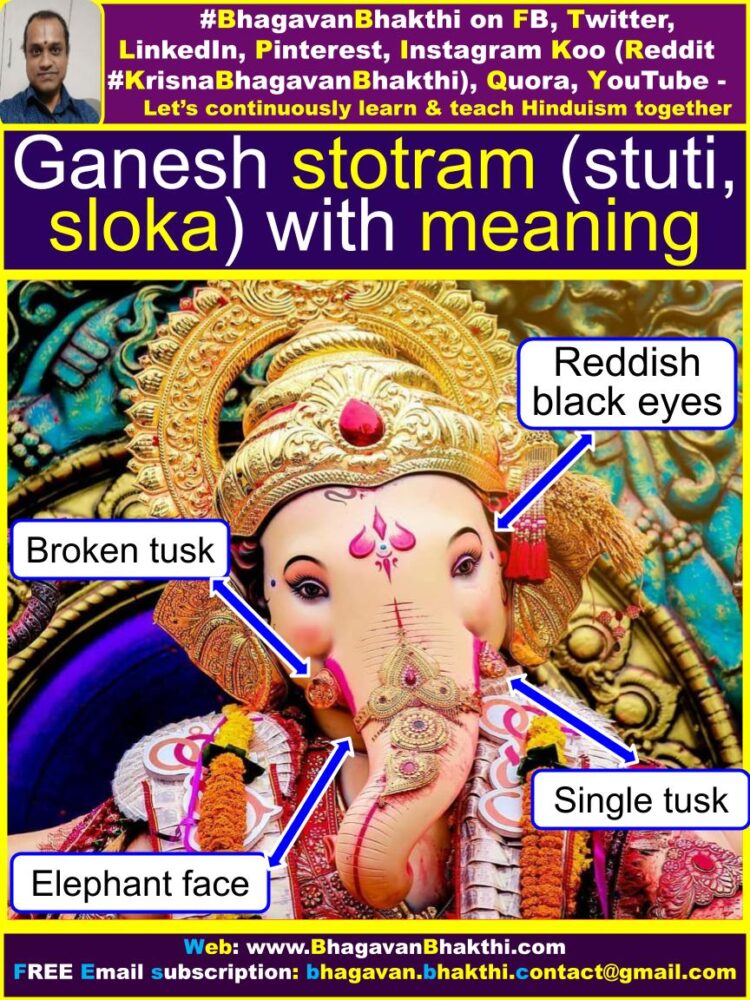
Shloka 3 : Word by word meaning of the above stotram (shloka) : laMbOdaraM = Having huge tummy; paMchamaM = Fifth; cha = And; ShaShThaM = Sixth; vikaTamEva = Someone who is cruel to his enemies; cha = And;
saptamaM = Seventh; vighnarAjEMdraM = Someone who is the king of obstacle remover; dhUmravarNaM = Someone who has his body as the color of smoke; tathAShTamaM = Having.
Shloka 3 : Full meaning of the above stotram (shloka) : Fifth is someone who has a very huge tummy, sixth as the one who is cruel to his enemies, seventh as the someone who is the king of removing all the obstacles, eighth as someone who has the color of smoke.
Shloka 4 : Word by word meaning of the above stotram (shloka) : navamaM = Ninth; bhAlachaMdraM = Someone who has crescent in his forehead; cha = And; dashamaM = Tenth; tu = You; vinAyakaM = Vinayaka (having humbleness);
EkAdashaM = Eleventh; gaNapatiM = Head of all the Ganas; dvAdashaM = Twelfth; tu = You; gajAnanaM = Having face of an Elephant.
Shloka 4 : Full meaning of the above stotram (shloka) : Ninth is someone who has the crescent in his forehead, tenth as the someone who is very humble in his nature,
eleventh as the leader of the army (Ganas) of Kailasa (Kailash) and twelfth is someone who has the face of an elephant.
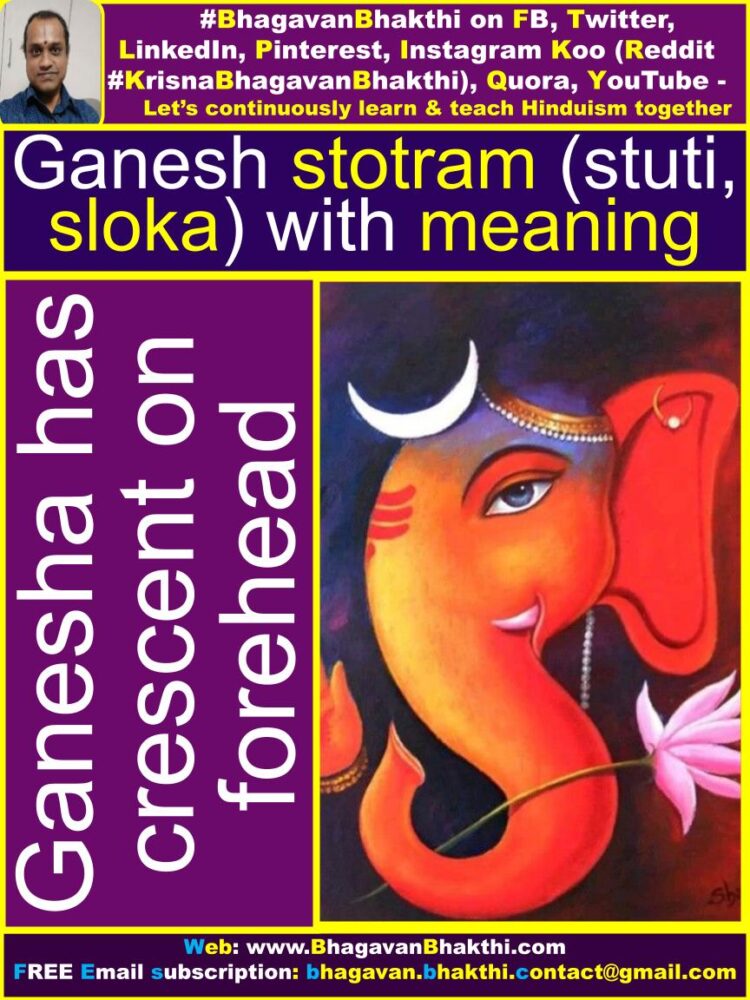
Shloka 5 : Word by word meaning of the above stotram (shloka) : dvAdashaitAni = Twelve; nAmAni = Names; trisaMdhyaM = Three times (Dawn, Noon and Dusk); yaH paThEnnaraH = Any human being; na = No; cha = And;
vighnabhayaM = No fear of obstacles; tasya = Like that; sarvasiddhikaraM = Perfection (achieving) in all; prabhO = God (Ganesha).
Shloka 5 : Full meaning of the above stotram (shloka) : Any one who reads these divine twelve names, at dawn, noon and dusk (this means from the time we wake and until the time we sleep),
we will never have the fear of defeat and he / she will always achieve whatever he / she wishes from Lord Ganesha.
Shloka 6 : Word by word meaning of the above stotram (shloka) : vidyArthi = Student; labhate = Gain; vidyAM = Education; dhanArthI = Someone seeking wealth; labhate = Gain; dhanaM = Wealth; putrArthi = Someone seeking children;
labhate = Gain; putrAn = Children; mOkShArthi = Someone wanting moksha / divine liberation; labhate = Gain; gatiM = Moksha (divine liberation).
Shloka 6 : Full meaning of the above stotram (shloka) : Someone who wants to get good education will get knowledge (education), someone who wants to gain wealth will get wealth,
someone who wishes for children will get children and someone who wants moksha (divine liberation) will get moksha.
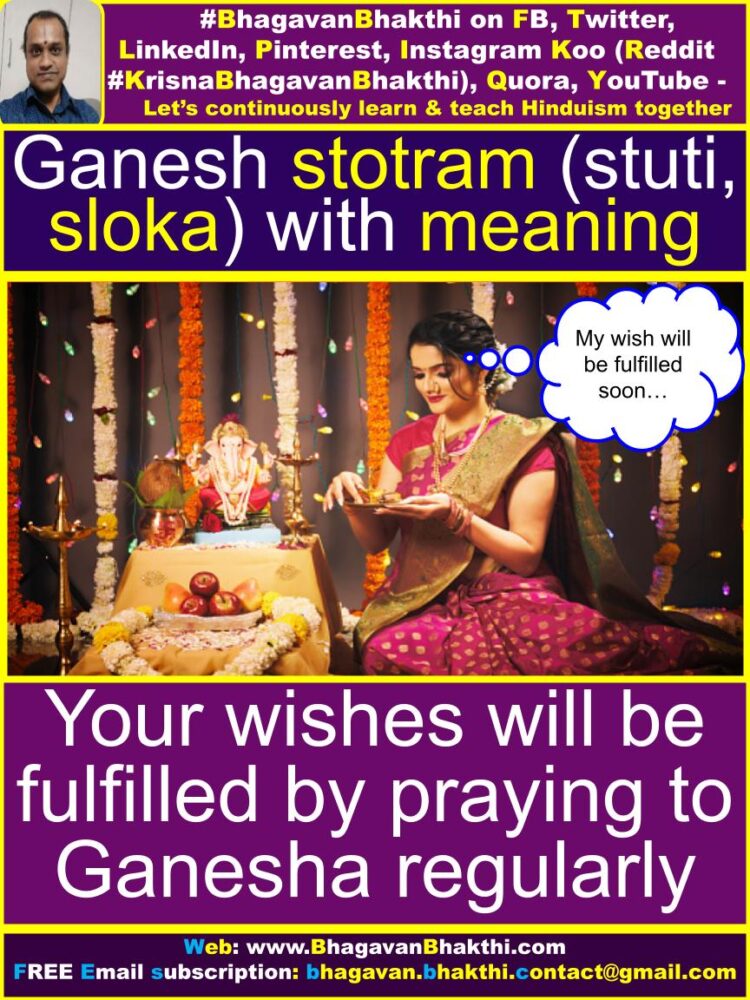
Shloka 7 : Word by word meaning of the above stotram (shloka) : japEt = Worshipping (praying); gaNapatistOtraM = Stotra of Ganapati (Ganesha); ShaDbhirmAsaiH = Within 6 months; phalaM = Fruits; labhEt = Will gain;
saMvatsarENa = One year; siddhiM = Perfection (achieving); cha = And; labhate = Gain; nAtra = There is no; saMshayaH = Doubt.
Shloka 7 : Full meaning of the above stotram (shloka) : Results of worshipping (chanting) this prayer of Ganapati (Ganesha), will be visible within six months and within a year, he / she will get all wishes fulfilled and there is no doubt about this.
Shloka 8 : Word by word meaning of the above stotram (shloka) : aShTebhyo = To Eight; brAhmaNEbhyashcha = Learned Brahmanas; likhitvA = In writing; yaH = This; samarpayEt =Offers; tasya = This; vidyA = Stotra;
bhavEt sarvA = All gain the stellar qualities; gaNEshasya = Lord Ganesha; prasAdataH = By the grace.
Shloka 8 : Full meaning of the above stotram (shloka) : Someone who gives this stotra (12 names’ stotra) in writing to eight learned Brahmanas (Brahmins) (wise people), and offers it to Lord Ganesha,
will become highly knowledgeable and also will be blessed with all stellar qualities by the blessings of Lord Ganesha.
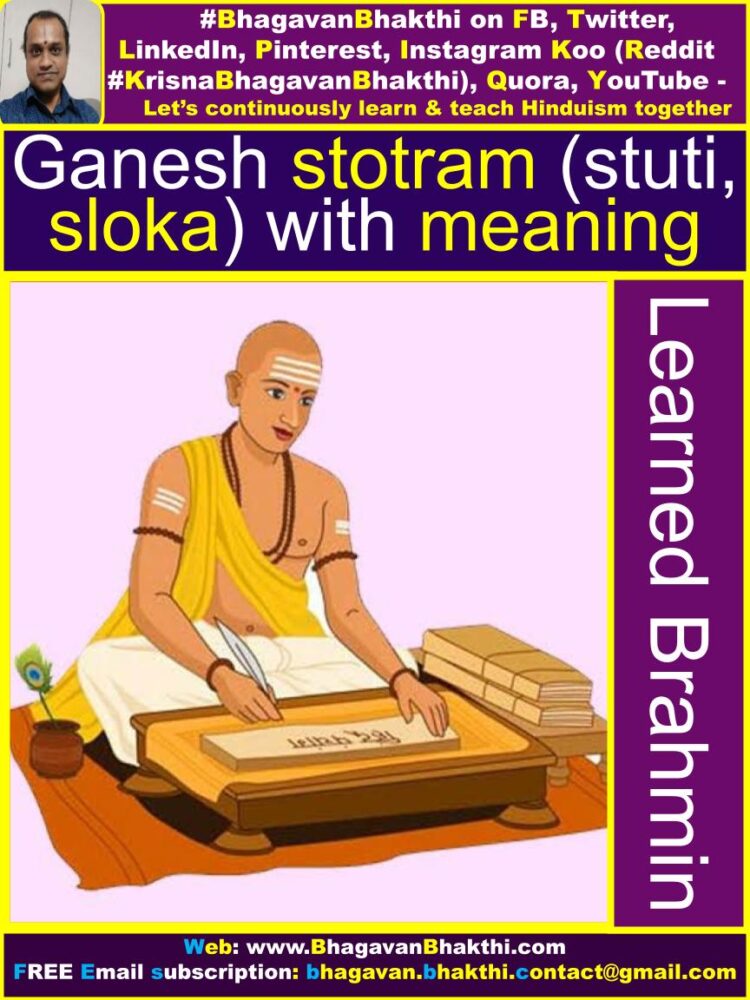
5. This below stotram (shloka) is given in Sanskrit (Hindi), Kannada and English script as below with meaning in English:
सुमुखश्चैक दंतश्च कपिलो गज कर्णिक |
लम्बोदरश्च विकटो विघ्नराजो गणाधिपतः || १ ||
धूम्र केतु गणाध्यक्ष फालचंद्रो गजाननः |
वक्रतुंड शूर्पकर्णो हेरंबः स्कंद पूर्वजः || २ ||
षोडशैतानी नामानि यः पठेत श्रुणु यादपि |
विद्यारंभे विवाहे च प्रवेशे निर्गमे तथा |
संग्रामे सर्व कार्येषु विघ्न स्तस्य न जायते || ३ ||
ಸುಮುಖಶ್ಚೈಕ ದಂತಶ್ಚ ಕಪಿಲೋ ಗಜಕರ್ಣಕಃ |
ಲಂಬೋದರಶ್ಚ ವಿಕಟೋ ವಿಘ್ನರಾಜೋ ಗಣಾಧಿಪಃ || 1 ||
ಧೂಮ್ರ ಕೇತುಃ ಗಣಾಧ್ಯಕ್ಷೋ ಫಾಲಚಂದ್ರೋ ಗಜಾನನಃ |
ವಕ್ರತುಂಡ ಶ್ಶೂರ್ಪಕರ್ಣೋ ಹೇರಂಬಃ ಸ್ಕಂದ ಪೂರ್ವಜಃ || 2 ||
ಷೋಡಶೈತಾನಿ ನಾಮಾನಿ ಯಃ ಪಠೇತ್ ಶೃಣು ಯಾದಪಿ |
ವಿದ್ಯಾರಂಭೇ ವಿವಾಹೇ ಚ ಪ್ರವೇಶೇ ನಿರ್ಗಮೇ ತಥಾ |
ಸಂಗ್ರಾಮೇ ಸರ್ವ ಕಾರ್ಯೇಷು ವಿಘ್ನ ಸ್ತಸ್ಯ ನ ಜಾಯತೇ || 3 ||
sumukhaścaika dantaśca kapilō gajakarṇakaḥ |
lambōdaraśca vikaṭō vighnarājō gaṇādhipaḥ || 1 ||
dhūmra kētuḥ gaṇādhyakṣō phālacandrō gajānanaḥ |
vakratuṇḍa śśūrpakarṇō hērambaḥ skanda pūrvajaḥ || 2 ||
ṣōḍaśaitāni nāmāni yaḥ paṭhēt śr̥ṇu yādapi |
vidyārambhē vivāhē ca pravēśē nirgamē tathā |
saṅgrāmē sarva kāryēṣu vighna stasya na jāyatē || 3 ||
Shloka 1 : Full meaning of the above stotram (shloka) : He is the God who is having pleasant face (Sumukha), he is the God with one tusk (Danta), he is the God who has reddish black eyes (Kapila),
he is the God with an elephant ears (Gaja Karnika), he is the God with a very broad tummy (Lambhodara), he is the God who is cruel to his enemies (Vikato), he is the God who is the remover of obstacles (Vignarajo), he is the God who is very humble (Vinayaka) in nature.
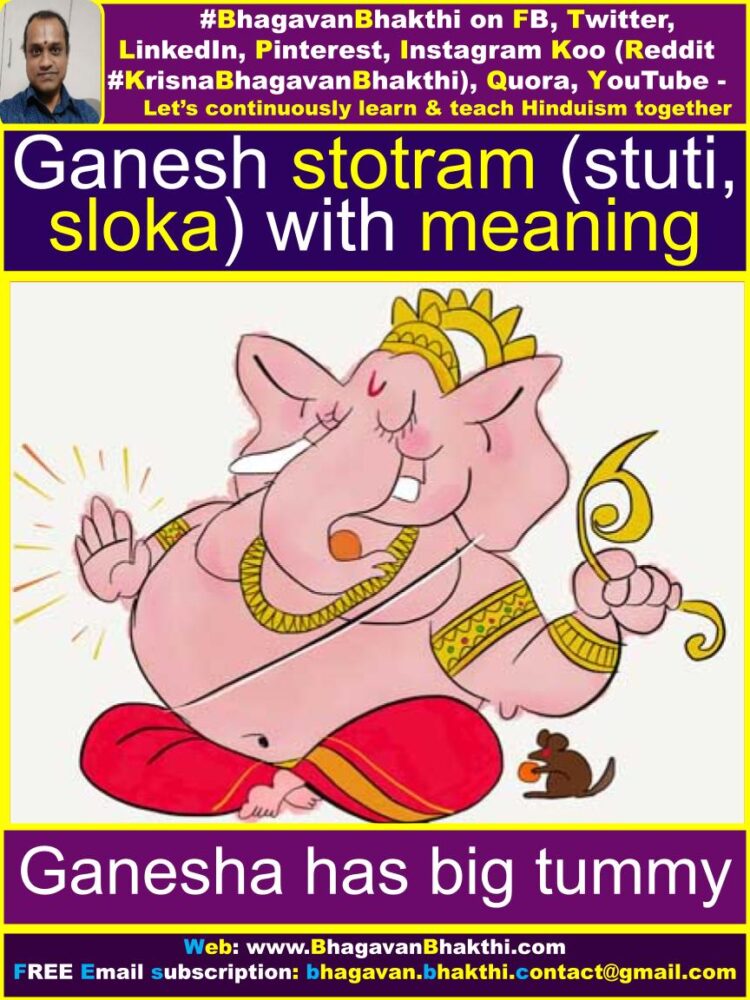
Shloka 2 : Full meaning of the above stotram (shloka) : He is the God who has the color of smoke (Dhoomraketu), he is the God who is head of an army (Ganas), he is the God who has crescent in his forehead (Phaalachandro),
he is the God who walks like an elephant (Gajanana), he is the God who has a broken tusk (Vakra tunda), he is the God who has very broad ears (Shoorpakarno),
he is the God who stays close to Lord Shiva (Herambah), he is the God who is elder brother (Poorvajah) of Skanda (Kartikeya).
Shloka 3 : Full meaning of the above stotram (shloka) : He is the God who reads (padet), hears (shrunu) are remembers (yaadapi) these above sixteen (Shoodashaitaani) names (naamaani), during the commencement of education (Vidhyarambhe),
during the marriage (vivaahe) ceremony, during the commencement (praveshe), end (nirgame) of any journey, during war (Sangraame) or for that matter during any matter (Sarvakaarye), will not (na) face any difficulties (vigna sthasya) and will attain victory.
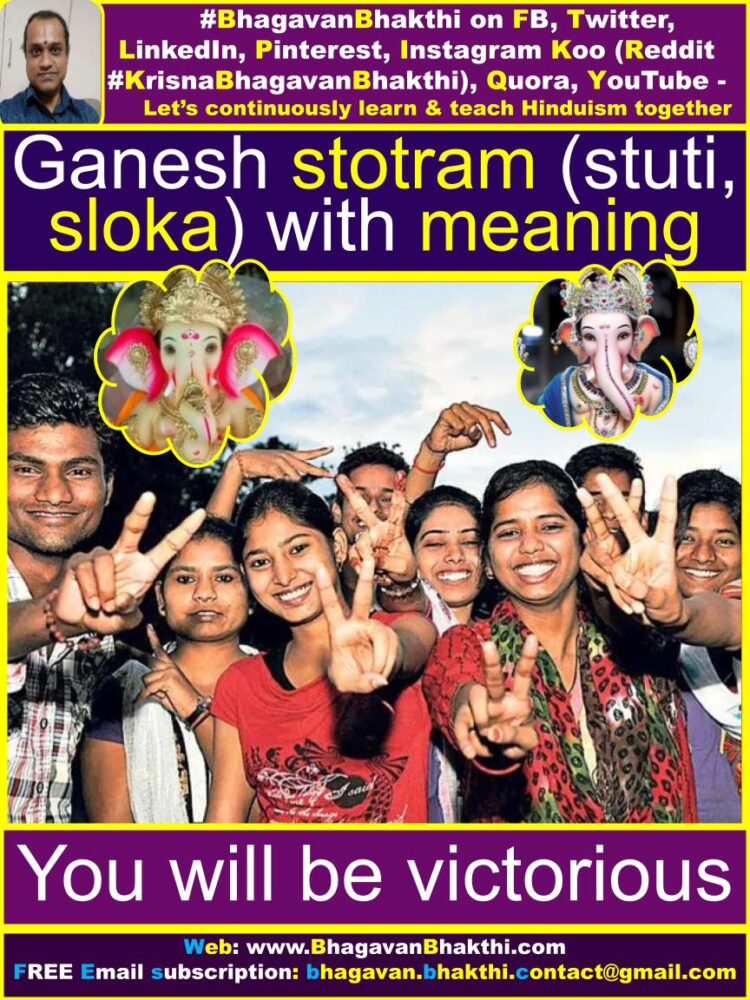
Continue reading about Lord Ganesha – Lord Ganesha information, facts, significance, importance etc.
More information will be added to this on regular basis, please visit after some time to know more information.
To watch videos on #Hinduism #Sanskrit language, SUBSCRIBE to my YouTube channel from this link: #BhagavanBhakthi YouTube channel
To know about different “Hindu Gods and Goddesses Stotrams / Stutis / Slokas” with meaning for kids and elders”, visit this link: Hindu Gods and Goddesses Stotrams / Stutis / Slokas
Dear friends, if you need any clarifications about this post, kindly let me know, I will definitely try to answer all of them.
Also your one LIKE, one COMMENT, One Share, one SUBSCRIPTION is highly important.
This will help to know the quality of this content and also it will be helpful to know if any improvements is required for the content.
If you feel this content is useful to you and has helped you to improve your knowledge, kindly share this with your well-wishers.
Because “SHARING MEANS CARING”.
To receive FREE EMAIL SUBSCRIPTION about #BhagavanBhakthi, you can send an email to [email protected] from your email ID.
NAMASTE!
Sri Gurubhyo Namaha
Sri Krishnaaya Namaha
Sri Krishnaarpanamastu
Subscribe / Follow us Share in Social Media